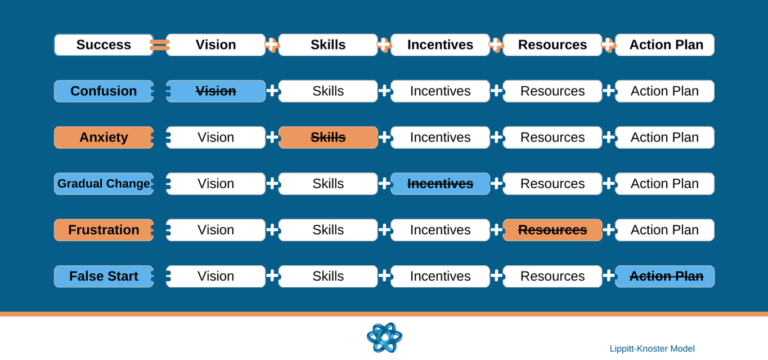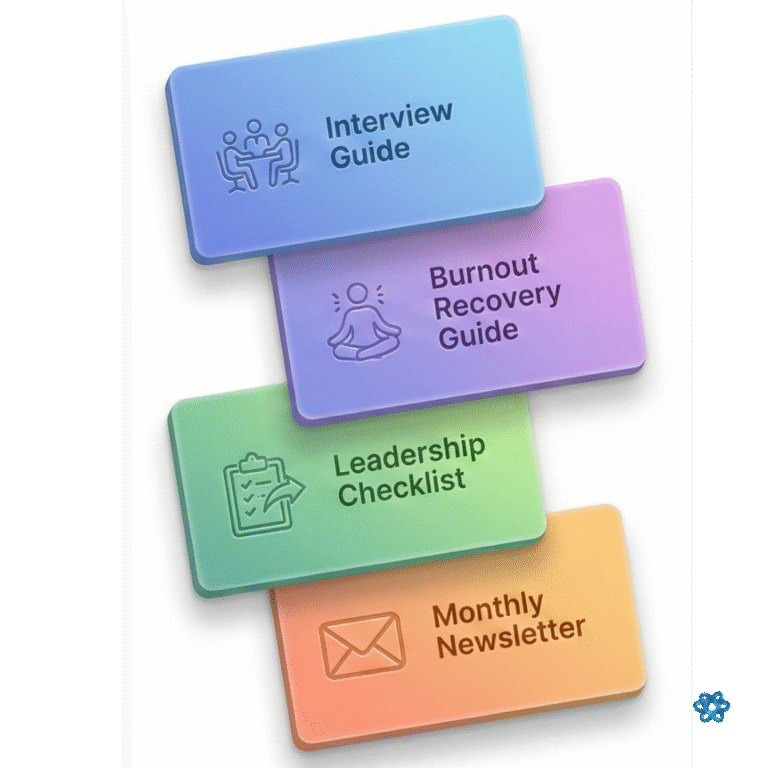The trauma of change fatigue
You’ve been there: a major company reorganization, a sudden team shift, or a pivot in your core role; feeling overwhelmed, confused, and deeply frustrated. The biggest cost of constant change isn’t the workload—it’s the psychological cost of trying to execute a plan when the fundamental pieces are missing. This constant confusion triggers anxiety and leads to a crippling sense of professional trauma, making every new initiative feel like an impossible task.
We often assume that resistance to change is personal, but that’s a misconception. True friction usually stems from a breakdown in the system. The good news? You can identify the exact missing component that’s causing the failure, reclaim your agency, and move forward.

The Lippitt-Knoster model as your mental roadmap
Your stability depends on successfully leading or navigating complex transitions. Instead of treating chaos as an emotional problem, we’ll use the Lippitt-Knoster Model for Complex Change (often referred to as the Change Matrix). This framework is critical to your emotional health and long-term stability because it provides a diagnostic tool for change failure.
When a change effort stalls, the model teaches us that it’s due to a missing component—not personal incompetence. By identifying the root cause (e.g., lack of Vision or Incentives), you move from feeling helpless to being strategic, dramatically reducing unnecessary mental drain. Like any system, we can work similarly – using this model for your mental roal

Diagnosing the five missing pieces
The Lippitt-Knoster Model suggests that successful change requires five elements. If one is missing, a specific negative outcome is guaranteed. Your task is to diagnose the “symptom” (the negative outcome) to identify the “cure” (the missing element).
| Missing Component | Guaranteed Outcome (The Symptom) | Example of Professional Impact |
| Vision (V) | Confusion | Your team is working hard but everyone is pulling in different directions. |
| Skills (S) | Anxiety | Employees feel competent in their old roles but stressed and fearful in the new one. |
| Incentives (I) | Gradual Resistance | People understand the change but revert to old habits when accountability drops. |
| Resources (R) | Frustration | The plan is clear, but people lack the time, tools, or budget to execute. |
| Action Plan (AP) | Treadmill Effect | Everyone agrees on the goal, but they don’t know the first concrete step to take. |
💡 Turning Symptoms into Strategy
Use this process to filter your next major change project. Do this, do this well. And you’ll be supporting yourself, your team, your department, and your organization to manage through this complex change.
1. Pinpoint the professional pain point
You’ve heard it once, twice, umpteenth time, write it down. Juggling the complexities of this can be a lot easier with paper and pen. So, start with acknowledging the pain. What is the current change effort that feels like a struggle?
What are the primary negative symptom?
Is it widespread or localized Confusion?
Is it palpable Frustration?
2. Analyze the missing element (the cure)
Based on the symptom/s you identified in Step 1, use the Change Matrix to find the missing component.
Case study: If your team is experiencing Frustration, the missing piece is almost certainly Resources. Your team lead expects you to learn a new complex software system (Vision is clear), but you haven’t been given training licenses or dedicated learning time (Resources are absent). The cure is requesting those resources, not working 60-hour weeks.
3. Determine your intervention strategy
Once you identify the missing element/s, your job shifts from struggling against the symptom to strategically advocating for the cure.
If Vision is missing (Confusion): Your intervention is to seek clarity. Ask specific, high-level questions: “What does success look like?”
If Skills are missing (Anxiety): Your intervention is to request training. Identify the specific KSA (Knowledge, Skills, and Abilities) required for the new role and ask, “Where is the budget for me to acquire this KSA?”
If Incentives are missing (Resistance): Your intervention is to connect the change to existing rewards (or suggest new ones). Ask: “How will successful adoption be reflected in performance reviews?”
4. Reclaim authority
Many professionals take on the stress of the missing piece as a personal burden. Stop trying to fix everything. Your action is simply to name the missing piece to the appropriate leader. You are providing an expert diagnosis, not volunteering for a sacrifice. Additionally, proactively solving a problem doesn’t help your career, but proactively identifying problems and working on a solution can help you in your professional development. When the problem becomes an issue for others, leadership, organization, department, then you can show how to take lead and resolve the issue.
Sadly, you have to have buy-in from leadership and organization to value the solution before you can be recognized for resolving a pain point. In the world of innovation, if you can’t define the pain point then there’s no need to change the status quo.

The power of self-reflection and boundaries
This framework offers an incredible opportunity for self-reflection. By applying the Matrix, you define the boundary between your responsibilities and systemic failures.
When you correctly identify that a change is failing due to lack of Vision (Confusion) or lack of Resources (Frustration), you gain a profound sense of control over your emotional life. You stop beating yourself up for not being able to manage the impossible. You use your self-awareness to protect your energy and advocate for necessary systemic changes, aligning your actions with your personal core value of efficiency or integrity.
Take a strategic pause. Do not let the organization’s disorganization become your exhaustion, this will lead you towards burnout.
Stop letting the chaos of poorly managed change dictate your professional worth.
You now have a powerful, clinical tool to diagnose failure, conserve your energy, and strategically advocate for the support you need.
Action checklist:
-
Identify the most frustrating change effort in your life right now.
-
Diagnose the core symptom (Confusion, Anxiety, Resistance, Frustration, or Treadmill Effect).
-
Name the one missing element (V, S, I, R, or AP).
-
Formulate one advocacy question based on the missing element.
If you are cycling through anxiety and frustration because of broken organizational systems, it’s time for external support to build your strategic influence. Schedule a FREE Consultation to use the Change Matrix and build a personalized plan to lead through complex professional transitions.

